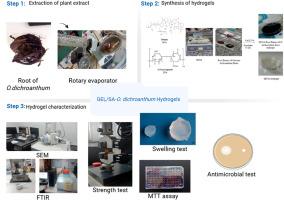Gelatin-sodium alginate hydrogel infused with Onosma dichroanthum Boiss. root extract: Preparation, characterization, and application in wound dressing
IF 2.2
Q3 BIOCHEMISTRY & MOLECULAR BIOLOGY
引用次数: 0
Abstract
Background
Chronic and acute wounds remain a major clinical challenge, often complicated by infection, delayed healing, and patient morbidity. Hydrogels have emerged as promising wound dressings due to their moist environment maintenance, exudate management, and capacity to deliver bioactive agents. However, many hydrogel systems rely on synthetic components or show limited antimicrobial efficacy and mechanical adaptability to diverse wound types. Natural polymers such as alginate and gelatin offer biocompatibility and tunable properties but frequently require enhancements to achieve optimal elasticity, degradation rates, and biological function. There is a critical need for a biocompatible, mechanically robust, and antimicrobial hydrogel platform that can be easily loaded with plant-derived bioactives to promote rapid and safe wound closure. The focus of this study was to prepare and characterize GEL/SA hydrogels incorporated with O. dichroanthum root extract for wound dressing applications.
Materials and methods
The hydrogel was synthesized using the casting and cross-linking method. Its physicochemical and antimicrobial properties were thoroughly evaluated.
Results
The GEL/SA–O. dichroanthum hydrogel demonstrated strong elasticity and promoted effective biodegradation, while GEL/SA–O. dichroanthum hydrogels exhibited excellent hemocompatibility. Additionally, these hydrogels showed significant antibacterial activity against Staphylococcus aureus (9 mm) and potent antifungal effects against Candida albicans (10 mm).
Conclusion
This study presents a GEL/SA hydrogel incorporated with Onosma dichroanthum root extract, achieving a unique combination of features: A dual-polymer natural matrix (gelatin-alginate) with tuned cross-linking that yields high mechanical stability while exhibiting controlled relaxation and enhanced elasticity after extract incorporation. Integration of O. dichroanthum root extract as a bioactive wound-healing constituent, delivering both anti-inflammatory and antimicrobial effects directly at the wound site. Demonstration of improved biodegradation kinetics and excellent hemocompatibility without compromising structural integrity or biocompatibility. Demonstration of significant antibacterial activity against Staphylococcus aureus and potent antifungal effects against Candida albicans, addressing common wound-infection challenges. A scalable, casting-and-crosslinking fabrication approach compatible with clinical translation and potential for combination with additional therapeutic agents.

明胶-海藻酸钠水凝胶注入双花草。根提取物:制备、表征及在伤口敷料中的应用
慢性和急性伤口仍然是一个主要的临床挑战,通常伴随感染、延迟愈合和患者发病率。水凝胶由于其湿润环境的维持、渗出液的管理和提供生物活性剂的能力而成为有前途的伤口敷料。然而,许多水凝胶系统依赖于合成成分或表现出有限的抗菌功效和对不同伤口类型的机械适应性。海藻酸盐和明胶等天然聚合物提供生物相容性和可调特性,但通常需要增强以达到最佳弹性,降解率和生物功能。目前迫切需要一种具有生物相容性、机械坚固性和抗菌性的水凝胶平台,这种平台可以很容易地装载植物源性生物活性物质,以促进快速和安全的伤口愈合。本研究的重点是制备和表征含有O. dichroanthum根提取物的GEL/SA水凝胶用于伤口敷料。材料与方法采用浇铸和交联法制备水凝胶。对其理化性能和抗菌性能进行了全面评价。ResultsThe凝胶/ SA-O。凝胶/ SA-O水凝胶具有较强的弹性,促进了有效的生物降解。双角anthum水凝胶具有良好的血液相容性。此外,这些水凝胶对金黄色葡萄球菌(9mm)和白色念珠菌(10mm)具有显著的抗菌活性。本研究提出了一种凝胶/SA水凝胶与石竹根提取物结合,实现了独特的组合特征:双聚合物天然基质(明胶-海藻酸盐)具有调节交联,具有高机械稳定性,同时在提取物结合后表现出可控的松弛和增强的弹性。整合菊花根提取物作为一种生物活性的伤口愈合成分,提供抗炎和抗菌作用直接在伤口部位。在不影响结构完整性或生物相容性的情况下,改善了生物降解动力学和良好的血液相容性。对金黄色葡萄球菌的显著抗菌活性和对白色念珠菌的有效抗真菌作用,解决常见的伤口感染挑战。一种可扩展的铸造交联制造方法,与临床翻译兼容,并有可能与其他治疗剂联合使用。
本文章由计算机程序翻译,如有差异,请以英文原文为准。
求助全文
约1分钟内获得全文
求助全文
来源期刊

Biochemistry and Biophysics Reports
Biochemistry, Genetics and Molecular Biology-Biophysics
CiteScore
4.60
自引率
0.00%
发文量
191
审稿时长
59 days
期刊介绍:
Open access, online only, peer-reviewed international journal in the Life Sciences, established in 2014 Biochemistry and Biophysics Reports (BB Reports) publishes original research in all aspects of Biochemistry, Biophysics and related areas like Molecular and Cell Biology. BB Reports welcomes solid though more preliminary, descriptive and small scale results if they have the potential to stimulate and/or contribute to future research, leading to new insights or hypothesis. Primary criteria for acceptance is that the work is original, scientifically and technically sound and provides valuable knowledge to life sciences research. We strongly believe all results deserve to be published and documented for the advancement of science. BB Reports specifically appreciates receiving reports on: Negative results, Replication studies, Reanalysis of previous datasets.
 求助内容:
求助内容: 应助结果提醒方式:
应助结果提醒方式:


